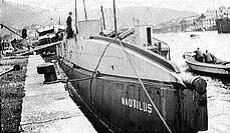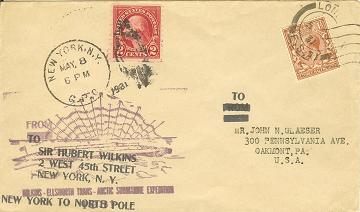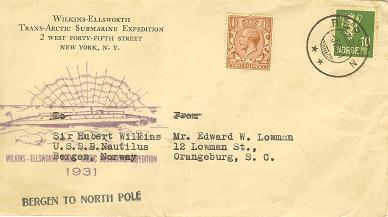|
The Wilkins- Ellsworth North Pole expedition
 Struck from the Naval Vessel Register on July 29,1930 the US Navy submarine O-12 was transferred to the United States Shipping Board for conversion by the Philadelphia Navy Yard. She was leased at the rate of one dollar per year to Lake and Dannenhower, Inc., of Bridgeport, Connecticut, for use on Hubert Wilkins`s and Lincoln Ellsworth`s Arctic Expedition of geophysical investigation. The lease required that she either be returned to the Navy for disposal, or scuttled in at least 1,200 feet (370 m) of water. Struck from the Naval Vessel Register on July 29,1930 the US Navy submarine O-12 was transferred to the United States Shipping Board for conversion by the Philadelphia Navy Yard. She was leased at the rate of one dollar per year to Lake and Dannenhower, Inc., of Bridgeport, Connecticut, for use on Hubert Wilkins`s and Lincoln Ellsworth`s Arctic Expedition of geophysical investigation. The lease required that she either be returned to the Navy for disposal, or scuttled in at least 1,200 feet (370 m) of water.
On March 24,1931she was re-named Nautilus. As Prohibition prevented the use of an alcoholic beverage, she was baptized not with the traditional champagne but rather with a bucket of ice cubes.
Simon Lake equipped Nautilus with several clever devices for under-ice operations. One was a mechanical probe, much like a trolley pole, that would scrape along the bottom of the ice cap to indicate how much clearance the submarine had below the ice. Others included drills supposedly capable of cutting through 13feet (4m) of ice to reach fresh air.
On June 4,1931 Nautilus with her crew of 20 men commanded by Captain Sloan Danenhower began the crossing from New York City to Plymouth, England, the first leg of the voyage that was planned to take them up the coasts of the North Sea to Spitsbergen and conclude with a dramatic rendezvous at the North Pole with Graf Zeppelin. On that first leg, however, Nautilus encountered a violent storm. Both engines failed, leaving the boat adrift. She was rescued and towed to England by USS Wyoming (BB-32) where she was repaired.
On August 5, very late in the year to begin an Arctic expedition, Nautilus began making her way through the English Channel and along the Norwegian coast. Another storm again damaged the boat, carrying away her bridge and giving her a permanent list, but after a stop in Tromso on August 11, she successfully raised Spitsbergen, and Wilkins allowed but a single day for repairs.
The crew carried out the planned scientific experiments as they pushed on northward, but thick pack ice hindered their progress. The boat was ill-equipped to deal with the extreme cold, lacking insulation and heaters. The fresh water system froze and the hull developed slow leaks.
After ten days, Nautilus reached 82°N, the farthest north any vessel had reached under its own power, and preparations began to dive and proceed under the ice. However, the boat refused to respond; the stern planes had been carried away at some unknown earlier time. Without them, the submarine could not control its depth while submerged, and the expedition had to be aborted.
 On August 31, under financial pressure from Hearst, who indicated by telegraph that Wilkins would not be paid if he did not continue, Wilkins ordered the submarine onward. Captain Danenhower ordered Nautilus trimmed down by the bow, and deliberately rammed an ice floe in an attempt to force the boat under. The maneuver worked in that Nautilus submerged, and became the first submarine to operate under the polar ice cap. However, her unconventional method of diving caused significant damage to her upper works. She was out of radio contact for days, was presumed lost, and rescue efforts were planned. In fact, she had actually traveled only a short distance under the ice before resurfacing through a polynya, but her radios had been badly damaged, requiring days to repair. On August 31, under financial pressure from Hearst, who indicated by telegraph that Wilkins would not be paid if he did not continue, Wilkins ordered the submarine onward. Captain Danenhower ordered Nautilus trimmed down by the bow, and deliberately rammed an ice floe in an attempt to force the boat under. The maneuver worked in that Nautilus submerged, and became the first submarine to operate under the polar ice cap. However, her unconventional method of diving caused significant damage to her upper works. She was out of radio contact for days, was presumed lost, and rescue efforts were planned. In fact, she had actually traveled only a short distance under the ice before resurfacing through a polynya, but her radios had been badly damaged, requiring days to repair.
The scientific crew continued their experiments, and their findings became the first paper published by the Woods Hole Oceanographic Institution. On September 20, Nautilus returned to Spitsbergen carrying invaluable data and with all crew alive. Hearst, however, considered the expedition a failure and carried out his threat, refusing to pay for the expedition.
The USS O-12 (SS-73)
USS O-12 (SS-73) was an O-class submarine of the United States Navy. Her keel was laid down on March 6, 1916 by the Lake Torpedo Boat Company, Bridgeport, Connecticut.
These later O-boats, O-11 through O-16, were designed by Lake Torpedo Boat to different specifications than the earlier Electric Boat designs. They performed poorly as compared to the Electric Boat units, and are sometimes considered a separate class.
O-12 was launched on September 26, 1917, and commissioned on October 18, 1918 with Lieutenant Commander J.E. Austin in command.
O-12 spent much of her career as a unit of Submarine Division 1, based at Coco Solo, Panama Canal Zone. She decommissioned on June 17, 1924 after just five and a half years of service, and was placed in reserve at the Philadelphia Navy Yard.
Following the expedition, O-12 was returned to the Navy Department. On November 30, 1931 she was towed three miles down a Norwegian fjord outside Bergen and scuttled in 1,138 feet (347 m) of water. In 1981 Norwegian divers found her wreck.
USS Skate (SSN-578)
In 1959, USS Skate (SSN-578) was the second submarine to reach the North Pole. Her crew conducted a tribute to Sir George Hubert Wilkins and scattered his ashes over the North Pole. The Navy confirmed on 27 March that "In a solemn memorial ceremony conducted by Skate shortly after surfacing, the ashes of Sir Hubert Wilkins were scattered at the North Pole in accordance with his last wishes."
Back to History Index
 |
United States |
|
Wilkins- Ellsworth Trans- Arctic Submarine Expedition, New York to North Pole, New york NY, 8 May, 1931 |
 |
United States |
|
Wilkins- Ellsworth Trans- Arctic Submarine Expedition, Bergen to North Pole, Bergen, 3 Aug', 1931 |
|